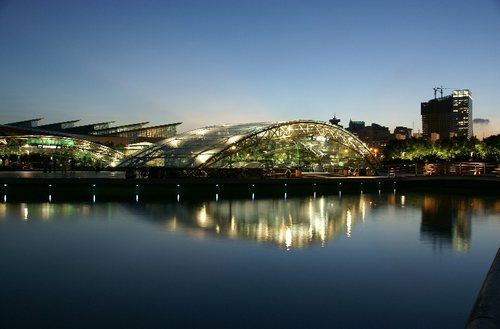Tonight I finally set the stage for an evening of "Sidewalk Astronomy". The place: the square outside the Science and Technology Museum subway station, for its high evening traffic and wide-open sky. The time: right after dinner on October 26, about 8pm, when Jupiter and the half-full moon were less than 15° away from each other.

On the way there I think I scared some people on the subway. First, the telescope I use belongs to the school so I carry it home in a long, black bag that looks just about the right size for carrying a firearm. I actually felt pretty spooky carrying it around, with my hoody and black jeans on. Second, I also brought along a homemade accelerometer and took some measurements of the subway acceleration and deceleration going from Longyang Rd to Century Park. It's just a piece of cardboard with a protractor made of paper taped on it, and a metal nut on fishing line hanging down, but I had placed it up against the wall and was staring at it intently trying to line it up to 0° as people were getting on at Longyang Rd, so it probably looked strange. The good thing is that the top acceleration I calculate based off the measurement falls within the ranges I found online; 1.2 m/s² is between 1.0-1.5 m/s².
At the Science and Technology Museum square, I set up just off the bridge where people cross over to walk toward the taxi line. The spot was central-ish, away from lights, and off to the side from where bikers and rollerbladers tend to ride. When I pulled out the telescope I immediately drew a small, curious crowd, which I satisfied with some conversation and a chance to look at the moon through the telescope and binoculars. Then when things settled down I lined the scope up with Jupiter on the higher power eyepiece and demonstrated what we were seeing in Stellarium on the laptop. Most of the people who stopped by were either older couples or families with kids; usually they drew near and smiled, at which point I asked them to take a look and they universally accepted. This usually lead to a bit of chit-chat about why I was there, or about astronomy. One grandfather was very cute; as his wife and their son and grandaughter walked away he ran back with… "One more question. Why can't we see so many stars these days? When I was young the sky was filled with them!" so we chatted a bit about the atmosphere and light pollution. Another man visiting Shanghai from Fujian got to talking about the time he had spent up north in Heilongjiang and how the sky up there was so vast and yet so near, the he felt like he could have reached up and touched it; he also recommended getting out of Shanghai and shared with me about how, American is great and all but, his dream is to first go to Tibet to find peace for his heart. By nine o'clock I was spending a lot of time on the laptop and practicing navigating the sky with the binoculars, and visitors were getting less frequent, so I closed up shop and took the subway/bus home.
Overall I consider the trip a success, but felt like the major advantage of the site, a wide open sky, was lost to the fact that light pollution (and a possible light cloud cover) washed out pretty much the whole sky, especially near the horizon. With that kind of sky I could just as well go to a more peopled site like People's Square or somewhere with more buildings, as long as I had a clear line of sight to the interesting objects for that night. This is a success I'd like to repeat.


0 Comments:
Post a Comment
« Home
Post a Comment